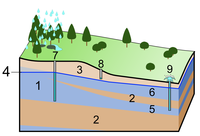
Photo from wikipedia
Abstract The properties of water in confined systems have been an interesting topic of research for years. The understanding of these properties is vital to many areas such as tribology… Click to show full abstract
Abstract The properties of water in confined systems have been an interesting topic of research for years. The understanding of these properties is vital to many areas such as tribology and microelectromechanical systems. Yet, it is very challenging to implement a cost-effective model to study water in confined systems with molecular dynamics simulations because these models typically require the use of grand-canonical (GC) simulation or thermodynamic extrapolation methods (TEM). In this work, we proposed and examined an alternative but effective model for the study of water in confined systems using the standard Large-scale Atomic/Molecular Massively Parallel Simulator (LAMMPS) without any additional customized subroutines. Two pseudo surfaces were used to play the role of pistons for maintaining pressure and two phosphorylcholine self-assembled monolayers (PC-SAM) were used as model surfaces to implement the confinement. Both the structure and dynamics of the water were investigated. In addition, the model was used to study the friction between the two surfaces, producing simulation results comparable to what has been reported in the literature. The calculated pressure of water between the surfaces was also in good agreement with experimental values. Therefore, the model may provide a cost-effective way to explore the properties of water in confined systems at the molecular level. In principle, the model should be applicable for other fluids in other confined systems as well.
Journal Title: Journal of Molecular Liquids
Year Published: 2019
Link to full text (if available)
Share on Social Media: Sign Up to like & get
recommendations!